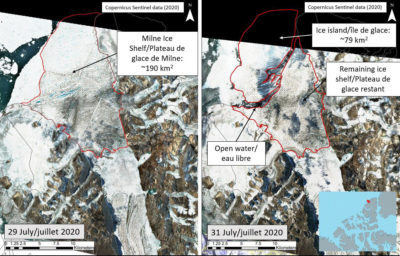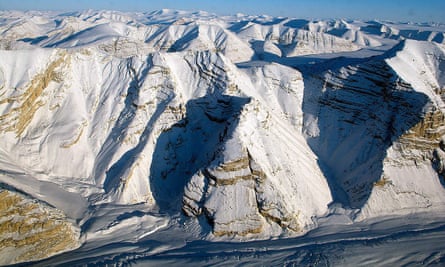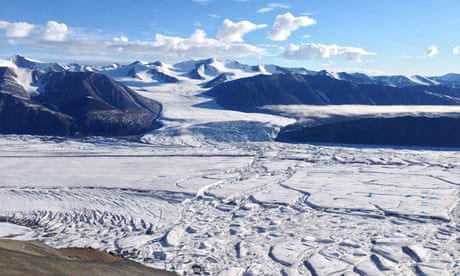Canada's last fully intact ice shelf has suddenly collapsed, forming a Manhattan-sized iceberg
The Milne ice shelf. Jérémie Bonneau/Carleton University
Almost half of Canada's last remaining intact ice shelf has suddenly collapsed into the ocean.
Almost half of Canada's last remaining intact ice shelf has suddenly collapsed into the ocean.
Satellite images show that it formed two icebergs, one of which is almost the size of Manhattan.
The collapse comes amid a summer that's seen hotter-than-average temperatures, which scientists say is a result of climate change.
A research camp was lost in the collapse.
A massive chunk of Canada's last fully intact ice shelf, some 4,000 years old, has broken off, reducing the shelf by more than half, scientists reported last Sunday. After separating from the shelf, the piece split in two, forming an iceberg almost the size of Manhattan.
Climate change likely fueled the collapse of the shelf, researchers said. This summer, the region's temperature was 9 degrees Fahrenheit warmer than the 1980 to 2010 average, Luke Copland, a glaciology professor at the University of Ottawa, told the Associated Press.
"Above normal air temperatures, offshore winds, and open water in front of the ice shelf are all part of the recipe for ice shelf break up," the Canadian Ice Service said on Twitter.
A research camp was lost when the shelf broke apart, as was the northern hemisphere's last known epishelf, a kind of freshwater lake, flanked by ice, that sits on top of ocean water.
Ice researcher Adrienne White takes a photo of fractures in the shelf. Luke Copland
'Entire cities are that size'
Located on the northwestern edge of Ellesmere Island, in the Canadian territory of Nunavut, the Milne ice shelf likely collapsed on July 30 or 31, according to ice analyst Adrienne White of the Canadian Ice Service. Satellite imagery shows that about 43% of the shelf broke off, forming pieces that were up to 260 feet thick.
"Entire cities are that size," Copland told Reuters. "This was the largest remaining intact ice shelf, and it's disintegrated, basically."
Unlike glaciers, which sit atop land, ice shelves float in the ocean. They're typically hundreds to thousands of years old and thicker than sea ice. Before the Milne ice shelf broke apart, it was larger than DC.
Temperatures rise faster in the Arctic
The Arctic is warming much faster than the rest of the world, a phenomenon known as polar amplification, and those hot temperatures are causing ice to melt. Today, for example, polar ice caps are melting six times faster than in the 1990s.
In Canada, there used to be a continuous ice shelf spanning the northern coast of Ellesmere, but human-made warming has caused it to break apart, White said. By 2005, Milne was "really the last complete ice shelf," she told the Associated Press.
While scientists considered Milne to be less vulnerable to collapse, as it's protected in the Milne Fiord, the shelf has sustained cracks over the years.
As Record Arctic Heat Continues, Canada’s Last Intact Ice Shelf Collapses

The Milne Ice Shelf in Canada lost nearly 40 percent of its ice over a two-day period in late July. ECCC CANADIAN ICE SERVICE
Canada’s last fully intact ice shelf in the Arctic has collapsed, shrinking by about 80 square kilometers, or 40 percent of its area, over just two days at the end of July, according to scientists at the Canadian Ice Service. The breakup of the ice was driven by record-setting temperatures in the region, which have measured 5 degrees Celsius (9 degrees Fahrenheit) above the 30-year average this summer.
“Entire cities are that size. These are big pieces of ice,” Luke Copland, a glaciologist at the University of Ottawa who was part of the research team studying the Milne Ice Shelf, located on Ellesmere Island in the Canadian territory of Nunavut, told Reuters. “This was the largest remaining intact ice shelf, and it’s disintegrated, basically.”
A research camp was lost in the collapse of the ice shelf. So was the northern hemisphere’s last known epishelf lake, a freshwater lake damned by ice that floats atop salty ocean water. In addition, two of Canada’s ice caps, located on the Hazen Plateau in St. Patrick Bay, disappeared completely this summer, two years earlier than scientists predicted, according to the National Snow & Ice Data Center (NSIDC) in Boulder, Colorado.
“When I first visited those ice caps, they seemed like such a permanent fixture of the landscape,” Mark Serreze, director of NSIDC and a geographer at the University of Colorado, Boulder, said in a statement. “To watch them die in less than 40 years just blows me away.”
The Arctic has warmed at a rate twice the global average in recent decades, but scientists say this summer has been even more extreme. In July, Arctic sea ice hit its lowest recorded extent. And the Russian Arctic has experienced record heat and wildfires, with temperatures exceeding 100 degrees F in the Siberian town of Verkhoyansk in late June.
Satellite animation, from July 30 to August 4, shows the collapse of the last fully intact #iceshelf in #Canada.
The Milne Ice Shelf, located on #EllesmereIsland in #Nunavut, has now reduced in area by ~43%. #MilneIceIsland #seaice #Arctic #earthrightnow #glacier pic.twitter.com/jjs1gawoxA— ECCC Canadian Ice Service (@ECCC_CIS) August 4, 2020
Canadian ice shelf area bigger than Manhattan collapses due to rising temperatures
Last fully intact ice shelf in the Canadian Arctic lost more than 40% of its areas in two days at the end of July

Glaciers on Canada’s Ellesmere Island on 1 April 2014. Photograph: Handout/Nasa
Reuters
Fri 7 Aug 2020
The last fully intact ice shelf in the Canadian Arctic has collapsed, losing more than 40% of its area in just two days at the end of July.
The Milne Ice Shelf is at the fringe of Ellesmere Island, in the sparsely populated northern Canadian territory of Nunavut.
“Above normal air temperatures, offshore winds and open water in front of the ice shelf are all part of the recipe for ice shelf break up,” the Canadian Ice Service said in a tweet earlier this week.

Canada's high Arctic glaciers at risk of disappearing completely, study finds
Read more
“Entire cities are that size. These are big pieces of ice,” said Luke Copland, a glaciologist at the University of Ottawa who was part of the research team studying the Milne Ice Shelf.
The shelf’s area shrank by about 80 sq km. By comparison, the island of Manhattan in New York covers roughly 60 sq km.
“This was the largest remaining intact ice shelf, and it’s disintegrated, basically,” Copland said.
The Arctic has been warming at twice the global rate for the last 30 years, due to a process known as Arctic amplification. But this year, temperatures in the polar region have been intense. The polar sea ice hit its lowest extent for July in 40 years. Record heat and wildfires have scorched Siberian Russia.
Summer in the Canadian Arctic this year in particular has been 5C above the 30-year average, Copland said.
That has threatened smaller ice caps, which can melt quickly because they do not have the bulk that larger glaciers have to stay cold. As a glacier disappears, more bedrock is exposed, which then heats up and accelerates the melting process.
“The very small ones, we’re losing them dramatically,” he said, citing researchers’ reviews of satellite imagery. “You feel like you’re on a sinking island chasing these features, and these are large features. It’s not as if it’s a little tiny patch of ice you find in your garden.“
The ice shelf collapse on Ellesmere Island also meant the loss of the northern hemisphere’s last known epishelf lake, a geographic feature in which a body of freshwater is dammed by the ice shelf and floats atop ocean water.
A research camp, including instruments for measuring water flow through the ice shelf, was lost when the shelf collapsed. “It is lucky we were not on the ice shelf when this happened,” said researcher Derek Mueller of Carleton University in Ottawa, in a 2 August blogpost.
Ellesmere also lost its two St Patrick Bay ice caps this summer.
“We saw them going, like someone with terminal cancer. It was only a matter of time,” said Mark Serreze, director of the National Snow and Ice Data Center (NSIDC) in Boulder, Colorado.
The vanishing was confirmed last month, when Nasa satellite shots of the region revealed a complete lack of snow and ice, said Serreze, who studied the caps as a graduate student on his first trip to the Arctic years ago. At the time, he said, the caps had seemed like immovable parts of the geography.
“When I was there in the 1980s I knew every square inch of those ice caps,” he said. “You have the memories. It’s like your first girlfriend.“
Meanwhile, another two ice caps on Ellesmere – called Murray and Simmons – are also diminishing and are likely to disappear within 10 years, Serreze said.
No comments:
Post a Comment